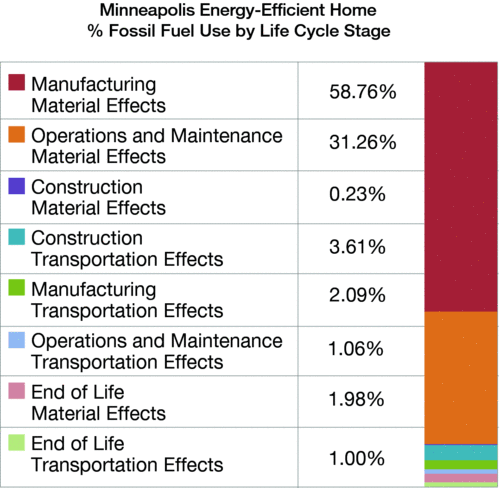Materials Matter
Manufacturing
The manufacturing of materials requires the greatest amount of energy in the entire construction process. In comparing the three materials, wood uses less energy to process than steel and concrete.
A mill for producing lumber is relatively straightforward. Bark is removed, logs are sawn, trimmed to produce smooth, parallel edges, cut to square and precise lengths, dried, and then planed, grade-stamped and packaged.
 |
Source: ATHENA® Impact Estimator for Buildings, version 4. 1.13. ATHENA is a registered trademark of the Athena Sustainable Materials Institute, www.athenaSMI.org |
The lumber industry has set its sights on getting the most out of every tree it uses. Industry in North America is taking the lead, converting more than 90 percent of every harvested log to valuable products with minimal waste.10 The statistic is attributable to state-of-the-art sawmilling that maximizes the quality and quantity of boards that can be cut from a tree, combined with further processing fiber that is unsuitable for lumber production into composite products such as OSB or fiber boards and paper. Bark, sawdust, shaving and other wood residuals are also used to generate electrical and thermal energy. Because its thermal energy requirements outweigh its electricity demand, the forest industry is well positioned to increase its production of bio-energy and other renewable bio-products in order to make even more efficient use of every tree harvested.
Carbon Emitted in Manufacture
|
 |
1/ Values are based on life cycle assessment and include gathering and processing of raw materials, primary and secondary processing, and transportation. 2/ Source: Adapted from USEPA (2006), Exhibit 2-3. *Data for concrete from Flower and Sanjayan (2007); 10% increase in energy consumption assumed for production of concrete block. 3/Carbon content of 49% of moisture free weight assumed for wood. Source: Dovetail Partners Inc |
Producing concrete requires mixing the cement, which has already been manufactured, with the mined aggregates. With the addition of water, the mixture starts to set. During this reaction, called hydration, the paste hardens to form concrete. Ready-mixed concrete is by far the most common form of concrete, accounting for up to 75 percent of the material made today. This is concrete that is "batched" from a central plant. Each batch is customized to the requirements of the specific job, and is delivered to site usually in cement mixer trucks. Concrete is used more than any other man-made material in the world.
Iron smelted from ore contains more carbon than is desirable. To become steel, the iron must be melted, again at extremely high temperatures, and reprocessed to reduce the carbon, and to remove silica, phosphorous and sulfur, which weaken the steel. Most modern steel plants use a basic oxygen furnace in which high-purity oxygen blows through the molten pig iron, lowering carbon levels and those of other impurities. Alloys are added at this time to create the desired properties of the steel product. Liquid steel is then cooled as bars or rods and later rolled and flattened into sheets for building ships, machinery and cans or made into steel girders for building skyscrapers and bridges.
Using wood products avoids the carbon emissions inherent in the industrial processes of concrete or steel products. While the concrete and steel industries are primarily powered by fossil fuels, many lumber companies use carbon-neutral wood waste to fuel their operations. Dovetail Partners Inc., which provides information about the impacts and trade-offs of environmental decisions, calls the lumber industry 50 to 60 percent energy self-sufficient overall.
While acknowledging valid uses for steel framing, including high-rise structures, the report Materials Selection in Framing: Is Steel Framing a Good Environmental Choice? states, "Even when considering steel framing that contains recycled content as high as 35 percent, considerable energy is consumed in the production process, and places steel products near the top of any embodied energy ranking of construction materials. The high conductivity of steel and associated need for energy-intensive insulation adds to the environmental burden of steel-framed structures. Finally, high energy intensity and manufacturing processes unique to steel translate to very high levels of emissions to air and water and global warming potentials."









